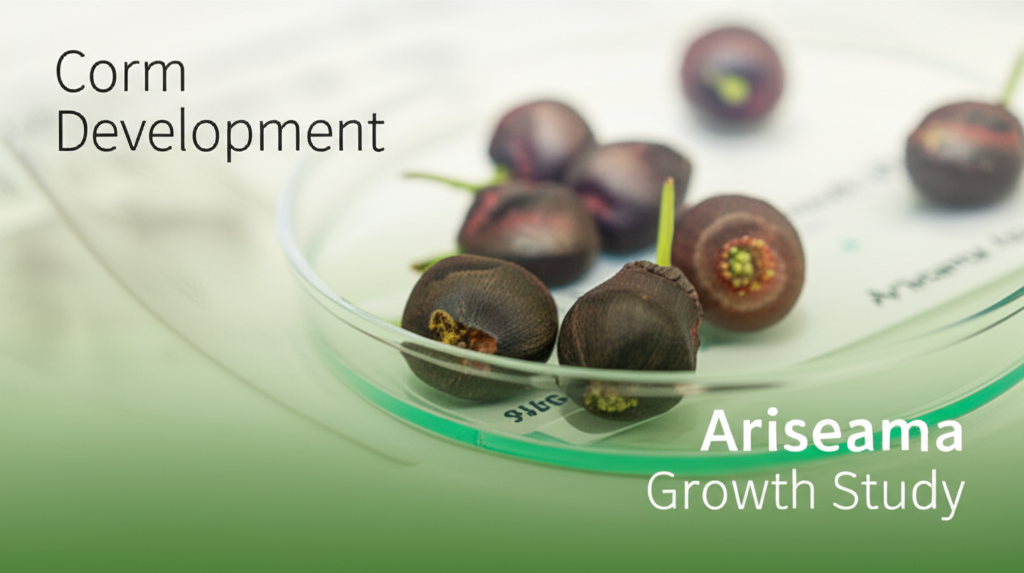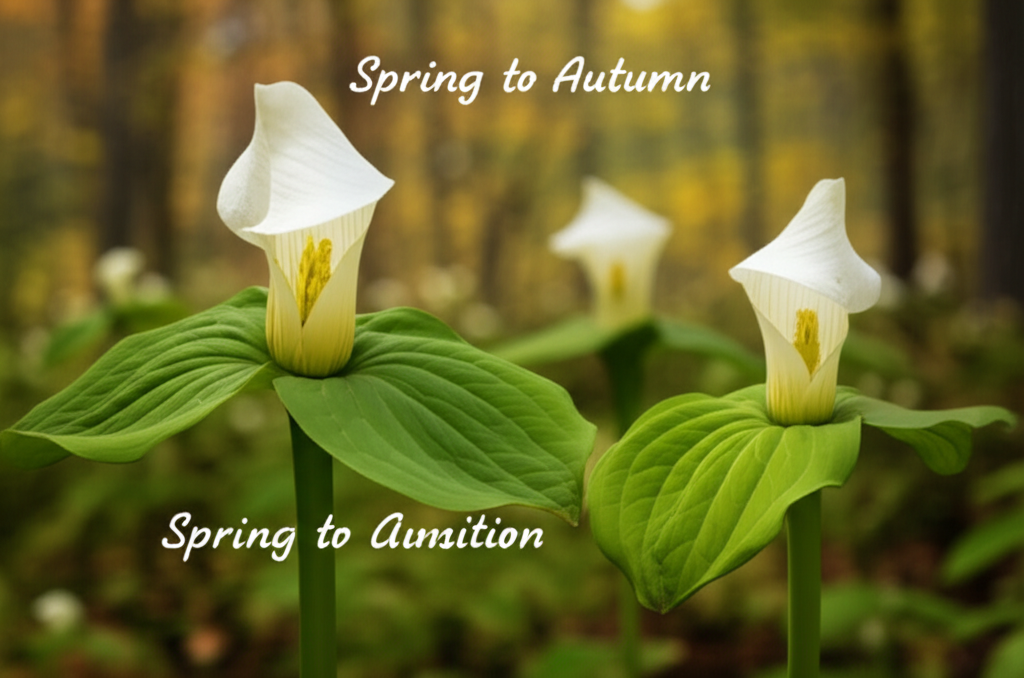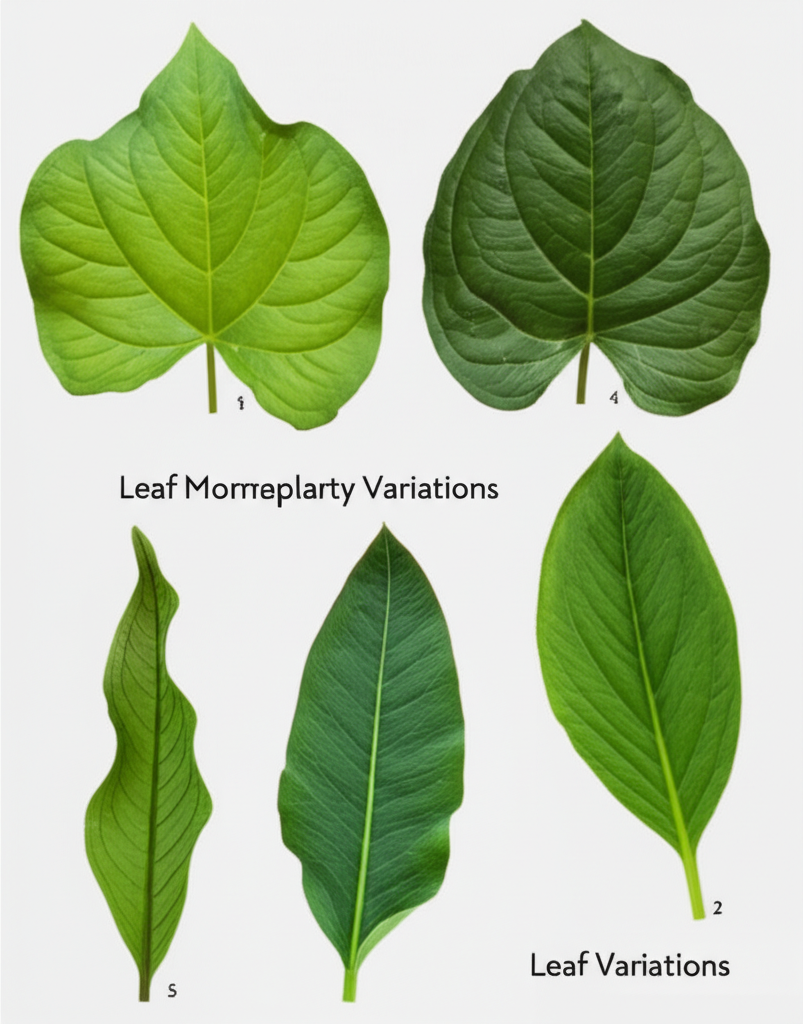The Allure of Jack-in-the-Pulpit
Jack-in-the-Pulpit, scientifically known as Arisaema triphyllum, is a captivating woodland wildflower native to eastern North America. Its distinctive hooded spathe, resembling a pulpit with a preacher inside, along with its unique reproductive cycle and fascinating ecological adaptations, makes it a compelling subject for botanical research and cultivation. For researchers and horticulturists alike, understanding and mastering the propagation of this plant is crucial for conservation efforts, ecological studies, and horticultural innovation. This guide delves into the intricacies of Jack-in-the-Pulpit propagation, providing a detailed roadmap for successful cultivation and research.
Understanding the Jack-in-the-Pulpit Life Cycle and Reproduction
Before embarking on propagation, a thorough understanding of Arisaema triphyllum‘s life cycle is paramount. This perennial herbaceous plant emerges from a corm, a swollen underground stem. It exhibits a remarkable form of sexual dimorphism, with plants typically being either male, female, or occasionally monoecious (possessing both male and female flowers on the same plant) or functionally asexual. The sex of a plant can change over its lifetime, often influenced by the availability of resources and the plant’s age and size.
The reproductive cycle begins with the flowering stalk emerging in spring, culminating in the iconic spathe and spadix. Pollination, primarily facilitated by fungal gnats and other small insects, leads to the development of a cluster of bright red berries in late summer or fall. These berries contain the seeds that are key to sexual propagation.
Methods of Jack-in-the-Pulpit Propagation
There are two primary methods for propagating Jack-in-the-Pulpit: sexual propagation through seeds and asexual propagation through corms. Each method offers unique advantages and challenges for botanical research.
1. Sexual Propagation: From Seed to Specimen
Sexual propagation, utilizing the seeds produced by the plant, is a fundamental method for genetic diversity and studying population dynamics. However, it is also the most challenging due to the intricate germination requirements of Arisaema triphyllum seeds.
Seed Collection and Preparation
- Timing: Seeds are typically ripe and ready for collection in late August through September, appearing as bright red berries.
- Collection: Carefully collect the ripe berry clusters. It is advisable to wear gloves as the berries can be mildly irritating to some individuals.
- Cleaning: The berries need to be processed to remove the fleshy pulp, which can inhibit germination and promote fungal growth. Gently crush the berries and rinse them thoroughly in water, rubbing the seeds to loosen any remaining pulp. Allow the seeds to air dry briefly on a paper towel.
- Stratification: Arisaema triphyllum seeds require a specific stratification process to break dormancy and prepare for germination. This involves simulating the natural winter conditions that the seeds would experience in their native habitat.
Cold, Moist Stratification: This is the most critical step. Mix the cleaned seeds with a sterile, moist medium such as peat moss, vermiculite, or a 50/50 mix of sand and peat. Place this mixture in a sealed plastic bag or container and store it in the refrigerator (around 35-40°F or 1-4°C) for a minimum of 90 days. Some research suggests that longer stratification periods, up to 180 days, can improve germination rates.
Warm Stratification (Optional but Recommended): Following cold stratification, a period of warm, moist stratification can further enhance germination. Transfer the seeds to a moist medium and keep them at room temperature (around 65-75°F or 18-24°C) for another 30-60 days.
Sowing and Germination
- Timing: Sow the stratified seeds in early spring, after the risk of frost has passed.
- Medium: Use a well-draining seed-starting mix. A common and effective mix includes equal parts peat moss, perlite, and compost.
- Sowing Depth: Sow the seeds about ¼ inch (0.6 cm) deep.
- Environment: Place the seed trays in a warm, brightly lit location. A greenhouse or a sunny windowsill with supplemental grow lights is ideal. Maintain consistent moisture in the soil, ensuring it is neither waterlogged nor dry.
- Patience: Germination can be slow and erratic, often taking several weeks to several months. Some seeds may not germinate until the following year, especially if they did not receive adequate stratification.
- Transplanting: Once the seedlings have developed a few true leaves and are large enough to handle, they can be transplanted into individual pots or directly into a prepared garden bed.
Challenges in Seed Propagation for Research
- Low Germination Rates: Achieving consistently high germination rates can be challenging due to the precise stratification requirements.
- Variability: Seed-grown plants exhibit genetic variability, which can be beneficial for studying phenotypic diversity but may require more rigorous standardization for controlled experiments.
- Time Commitment: The entire process, from seed collection to a flowering plant, can take several years (typically 3-5 years), demanding a long-term commitment for research projects.
2. Asexual Propagation: Corm Division and Offsets
Asexual propagation methods, primarily through corm division and the natural production of offsets, allow for the rapid multiplication of established plants with known genetic traits. This is often preferred for horticultural purposes and for establishing genetically identical study groups in research.
Corm Division
- Timing: The best time for corm division is in late fall after the foliage has died back or in early spring before new growth emerges.
- Excavation: Carefully dig up the mature corms, being mindful of their fragile nature.
- Division: Examine the corms for any smaller bulblets or offsets attached to the main corm. Using a clean, sharp knife or trowel, carefully separate these offsets from the parent corm. Ensure that each division has at least one viable bud or growing point.
- Drying and Storage (Optional): If dividing in the fall and not replanting immediately, allow the divided corms to air dry in a cool, dry, well-ventilated area for a few days to heal any cuts and prevent rot. Store them in a medium like peat moss or vermiculite in a cool, dark place until planting time.
- Replanting: Replant the divided corms at the same depth as they were previously growing, typically 2-4 inches (5-10 cm) deep, in well-draining soil.
Offsets (Bulblets)
- Natural Production: Jack-in-the-Pulpit naturally produces small bulblets or offsets around the base of the parent corm. These are essentially miniature versions of the corm.
- Separation: These offsets can be carefully detached from the parent corm during division or even gently separated from established plants growing in the ground when they are large enough to handle and have their own root systems.
- Growth: Offsets may take a year or two to reach flowering size but will grow into full-sized plants.
Advantages of Corm Division for Research
- Speed: Corm division offers a much faster route to obtaining mature plants compared to seed propagation.
- Genetic Uniformity: This method produces clones of the parent plant, ensuring genetic consistency within experimental groups, which is highly valuable for controlled research.
- Reliability: Generally a more reliable method than seed propagation, yielding a higher success rate.
Environmental Requirements for Successful Cultivation
Regardless of the propagation method, providing the correct environmental conditions is crucial for the health and success of Arisaema triphyllum.
Soil and Site Selection
- Soil Type: Jack-in-the-Pulpit thrives in rich, humusy, well-draining soil. A loamy soil with a good amount of organic matter, such as compost or well-rotted leaf mold, is ideal.
- pH: The preferred soil pH is slightly acidic to neutral, typically between 5.5 and 7.0.
- Location: Plant in a location that mimics its native woodland habitat. This means partial to full shade. Morning sun with afternoon shade is often perfect. Avoid direct, intense sunlight, which can scorch the leaves.
- Moisture: While they prefer consistently moist soil, they do not tolerate waterlogged conditions. Ensure good drainage to prevent corm rot.
Watering and Fertilization
- Watering: Water regularly, especially during dry periods, to keep the soil consistently moist. Avoid letting the soil dry out completely. Reduce watering once the foliage begins to yellow and die back in late summer.
- Fertilization: Amending the soil with compost annually is often sufficient. If fertilization is needed, use a balanced, slow-release organic fertilizer in early spring. Avoid over-fertilizing, which can lead to leggy growth and increase susceptibility to pests and diseases.
Pest and Disease Management
- Common Pests: Slugs and snails are the most common pests, feeding on the leaves and flowers. Regular monitoring and organic slug baits or barriers can help.
- Diseases: Root rot can occur in poorly drained soil. Ensuring good drainage and avoiding overwatering are the best preventative measures. Fungal leaf spots can sometimes occur but are rarely severe enough to warrant intervention in a naturalistic setting.
Key Facts and Comparison of Propagation Methods
To aid in planning botanical research, the following table summarizes the key characteristics of seed versus corm propagation.
Table 1: Key Facts and Comparison of Propagation Methods
| Feature | Seed Propagation | Corm Division / Offsets |
| :—————- | :———————————————– | :———————————————– |
| Genetic Diversity | High; results in variable offspring | Low; produces clones of the parent plant |
| Time to Maturity | Long (3-5 years to flowering) | Shorter (1-2 years to flowering from offsets) |
| Success Rate | Lower; requires precise stratification | Higher; more reliable |
| Effort | High; meticulous attention to stratification | Moderate; requires careful handling of corms |
| Research Application | Studying genetic variation, population studies | Establishing consistent experimental groups, rapid multiplication |
| Starting Material | Seeds from ripe berries | Mature corms or naturally produced bulblets |
| Dormancy | Requires significant dormancy breaking (stratification) | Dormancy is naturally broken with division/planting |
Step-by-Step Propagation Plan for Botanical Research
This section outlines a practical plan for researchers looking to propagate Arisaema triphyllum.
Table 2: Propagation Steps, Pros, and Cons
| Step | Seed Propagation | Corm Division / Offsets |
| :————————————— | :——————————————————————————————————————————————————————————- | :——————————————————————————————————————————————————————————— |
| 1. Seed Collection & Cleaning | Collect ripe berries in fall. Clean pulp thoroughly to expose seeds. Air dry briefly. | N/A |
| 2. Stratification | Cold: 90-180 days @ 35-40°F (1-4°C) in moist medium. Warm (optional): 30-60 days @ 65-75°F (18-24°C). | N/A |
| 3. Sowing | Early spring. Sow ¼ inch deep in well-draining seed mix. Maintain consistent moisture and warmth. | Late fall or early spring. Excavate corms, carefully divide offsets, ensuring each has a bud. Replant at 2-4 inches depth in well-draining soil. |
| 4. Germination & Early Growth | Slow and erratic (weeks to months). Provide light and moisture. Seedlings are delicate. | Offsets will typically sprout in the spring following division. Corms are robust. |
| 5. Transplanting | Transplant seedlings when they have true leaves into pots or beds. Handle gently. | Corms are replanted directly. |
| 6. Ongoing Care | Provide partial shade, consistent moisture, and protection from extreme temperatures. Allow plants to mature over several years. | Provide partial shade, consistent moisture. Plants grown from offsets will establish more quickly than seedlings. |
| Pros | – Introduces genetic diversity.
– Essential for studying natural variation and population genetics.
– Can result in novel traits. | – Faster to maturity.
– Produces genetically identical plants (clones).
– Higher success rate.
– Good for establishing replicated experimental units. |
| Cons | – Very slow.
– Low and erratic germination rates.
– Requires precise stratification.
– Difficult to control genetic uniformity for some studies.
– High failure rate possible. | – Lacks genetic diversity.
– Risk of disease transmission if corms are not healthy.
– Requires existing parent plants. |
| Research Suitability | Population genetics, ecological adaptation studies, breeding programs, conservation genetics. | Controlled experiments requiring genetic uniformity, physiological studies, horticultural trials, establishing reference collections. |
Advanced Considerations for Botanical Research
For specialized botanical research, several advanced propagation techniques and considerations can be employed:
- Controlled Environment Agriculture (CEA): Utilizing growth chambers or greenhouses with precisely controlled temperature, humidity, light intensity, and photoperiod can optimize germination and early growth for both seed and corm propagation. This allows for the study of specific environmental factors influencing development.
- Tissue Culture: While not as commonly published for Arisaema triphyllum as for some other genera, tissue culture techniques (micropropagation) could potentially be explored for rapid, disease-free multiplication of elite specimens. This would involve using sterile explants (e.g., meristematic tissue) to generate callus or plantlets in vitro.
- Corm Storage and Dormancy Manipulation: Research into optimizing corm storage conditions and techniques to artificially manipulate dormancy could accelerate the propagation cycle or allow for year-round planting trials.
- Genetic Marker Analysis: Alongside propagation, employing genetic marker analysis (e.g., microsatellites, SNPs) can verify the genetic identity and diversity of propagated individuals, ensuring the integrity of research cohorts.
- Pollination Studies: Researchers can control pollination by bagging flowers and hand-pollinating specific genotypes to study gene flow, inheritance patterns, and the development of specific traits.
Conclusion: Cultivating the Future of Arisaema Research
The successful propagation of Jack-in-the-Pulpit is a rewarding endeavor that opens doors to a deeper understanding of this unique woodland plant. Whether pursuing the genetic diversity offered by seed propagation or the controlled uniformity of corm division, meticulous attention to detail, environmental conditions, and reproductive biology is key. By mastering these techniques, botanical researchers can contribute significantly to the conservation, study, and appreciation of Arisaema triphyllum, ensuring its place in our native ecosystems and in scientific inquiry for generations to come.
html
<h2>Key Facts and Comparison for Jack-in-the-Pulpit Propagation</h2>
<table>
<thead>
<tr>
<th>Characteristic</th>
<th>Seed Propagation</th>
<th>Corm Division</th>
<th>Tissue Culture (<em>in vitro</em>)</th>
</tr>
</thead>
<tbody>
<tr>
<td><strong>Starting Material</strong></td>
<td>Seeds</td>
<td>Dormant corms (underground stems)</td>
<td>Meristematic tissue or small plantlets</td>
</tr>
<tr>
<td><strong>Germination/Establishment Time</strong></td>
<td>Slow (1-3 years for maturity)</td>
<td>Moderate (1-2 years for maturity)</td>
<td>Fast (months to maturity)</td>
</tr>
<tr>
<td><strong>Genetic Fidelity</strong></td>
<td>Variable (potential for segregation of traits)</td>
<td>High (clones of parent plant)</td>
<td>High (clones of parent plant)</td>
</tr>
<tr>
<td><strong>Ease of Execution</strong></td>
<td>Moderate to Difficult (requires specific stratification)</td>
<td>Moderate</td>
<td>Difficult (requires sterile lab conditions and expertise)</td>
</tr>
<tr>
<td><strong>Scalability</strong></td>
<td>High (with sufficient seed collection)</td>
<td>Moderate (limited by parent plant availability)</td>
<td>Very High (can produce large numbers of plants)</td>
</tr>
<tr>
<td><strong>Disease/Pest Risk</strong></td>
<td>Lower in early stages if seeds are clean</td>
<td>Moderate (risk of corm rot if not handled properly)</td>
<td>Very Low (controlled environment)</td>
</tr>
<tr>
<td><strong>Research Application</strong></td>
<td>Genetic diversity studies, breeding programs</td>
<td>Clone production, maintaining specific phenotypes</td>
<td>Rapid multiplication of elite genotypes, disease elimination</td>
</tr>
</tbody>
</table>
<h2>Jack-in-the-Pulpit Propagation: Steps, Pros, and Cons</h2>
<h3>Seed Propagation</h3>
<table>
<thead>
<tr>
<th>Step</th>
<th>Description</th>
<th>Pros</th>
<th>Cons</th>
</tr>
</thead>
<tbody>
<tr>
<td><strong>Seed Collection & Dormancy Breaking</strong></td>
<td>Collect ripe berries (red or orange), stratify seeds (cold, moist treatment) for 3-6 months.</td>
<td>Allows for genetic diversity; potentially easier to acquire large quantities.</td>
<td>Time-consuming dormancy requirement; variable germination rates; long time to maturity.</td>
</tr>
<tr>
<td><strong>Sowing & Germination</strong></td>
<td>Sow stratified seeds in well-draining soil mix; maintain consistent moisture and shade.</td>
<td>Can lead to new genetic combinations.</td>
<td>Susceptible to damping-off; slow initial growth.</td>
</tr>
<tr>
<td><strong>Seedling Care</strong></td>
<td>Provide consistent moisture, partial shade, and protection from pests.</td>
<td>Plants will develop their natural growth patterns.</td>
<td>Requires patience and careful monitoring for several years.</td>
</tr>
</tbody>
</table>
<h3>Corm Division</h3>
<table>
<thead>
<tr>
<th>Step</th>
<th>Description</th>
<th>Pros</th>
<th>Cons</th>
</tr>
</thead>
<tbody>
<tr>
<td><strong>Corm Excavation & Division</strong></td>
<td>Carefully dig up dormant corms in late fall or early spring; divide larger corms into smaller sections, ensuring each has an "eye" or growing point.</td>
<td>Produces genetically identical clones; relatively faster than seeds to flowering.</td>
<td>Requires careful handling to avoid damage; risk of corm rot if planted too deep or in wet conditions.</td>
</tr>
<tr>
<td><strong>Curing & Planting</strong></td>
<td>Allow cut surfaces to dry and callus for a few days (optional); plant corms at appropriate depth in well-draining soil with dappled shade.</td>
<td>Ensures better establishment and reduces rot.</td>
<td>Parent plant must be healthy and of sufficient size to divide.</td>
</tr>
<tr>
<td><strong>Post-Planting Care</strong></td>
<td>Water consistently, mulch to retain moisture, and protect from slugs and snails.</td>
<td>Supports rapid initial growth.</td>
<td>Overwatering can lead to corm failure.</td>
</tr>
</tbody>
</table>
<h3>Tissue Culture (<em>in vitro</em>)</h3>
<table>
<thead>
<tr>
<th>Step</th>
<th>Description</th>
<th>Pros</th>
<th>Cons</th>
</tr>
</thead>
<tbody>
<tr>
<td><strong>Explant Sterilization</strong></td>
<td>Surface sterilize small pieces of corm tissue or shoot tips.</td>
<td>Eliminates surface contaminants.</td>
<td>Can damage delicate plant tissues; requires precise chemical concentrations.</td>
</tr>
<tr>
<td><strong>Culture Initiation & Multiplication</strong></td>
<td>Place sterile explants on a nutrient-rich medium containing plant hormones; subculture to induce shoot and root development.</td>
<td>Rapid propagation of large numbers of plants; can overcome dormancy.</td>
<td>Requires sterile laboratory conditions and specialized media; genetic instability can occur with prolonged culture.</td>
</tr>
<tr>
<td><strong>Acclimatization</strong></td>
<td>Transfer plantlets from sterile conditions to a soil-based medium in a controlled environment.</td>
<td>Gradually prepares plants for ex-vitro conditions.</td>
<td>High mortality rate if not done correctly; plants are vulnerable to environmental changes.</td>
</tr>
</tbody>
</table>



